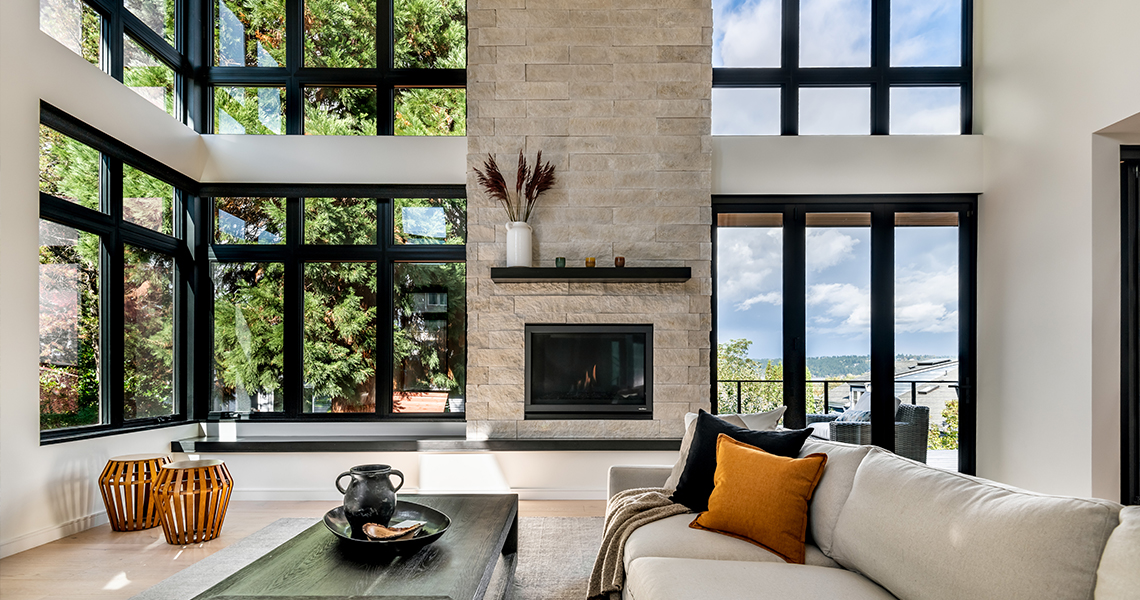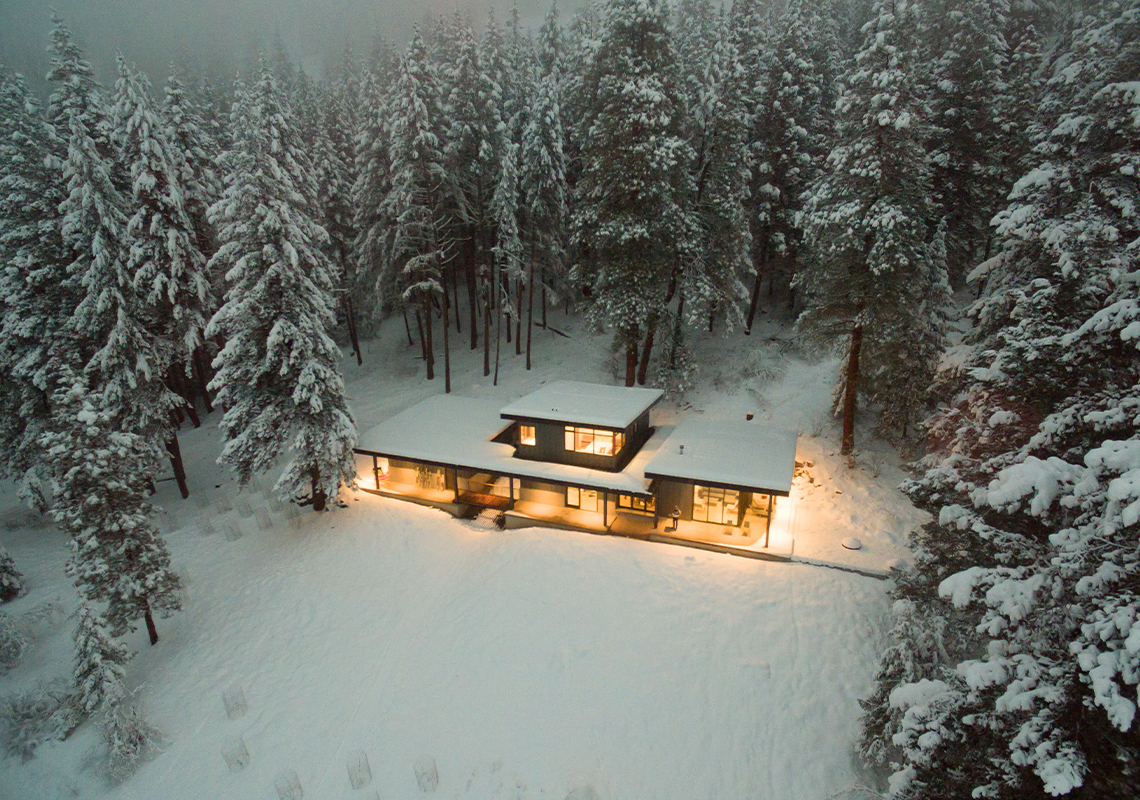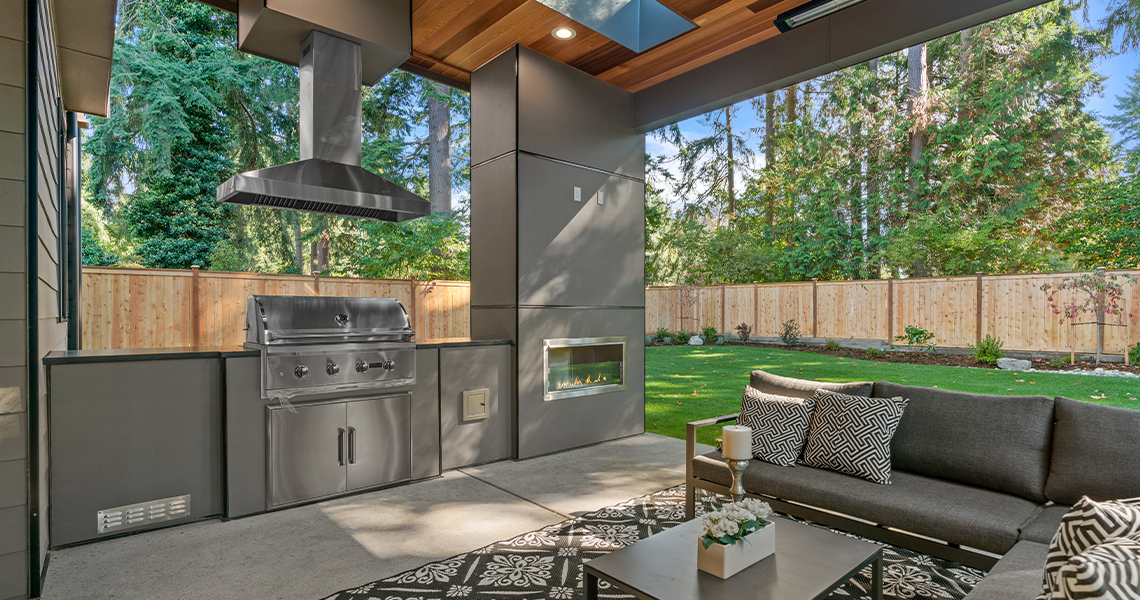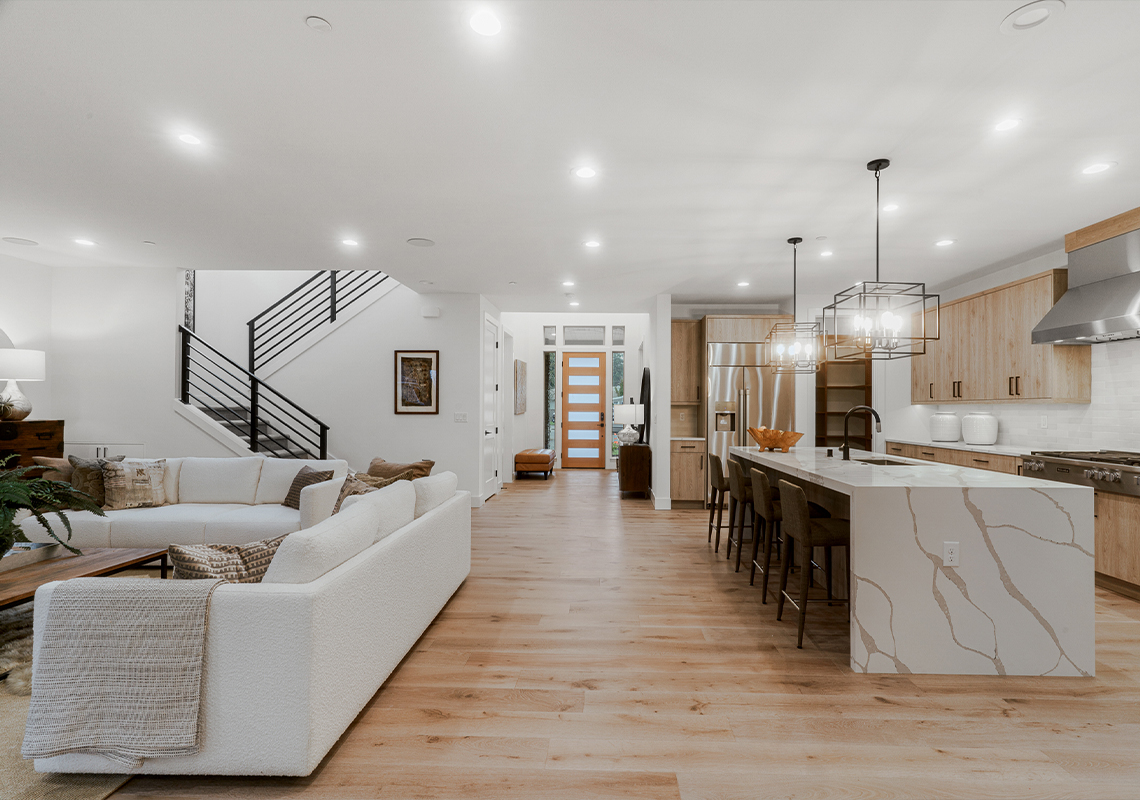By MBAKS Content Strategist James Slone
What makes a house a home? Is it an inviting
place to raise a family, an escape from life’s
worries, or a vantage point to take in nature? Is
it a sustainable retreat or a base of operations
in a bustling city? It’s all up to the people living there.
But what makes a home amazing? Building a truly
inspiring abode requires a touch of magic. To find out
what that magic is, I talked to two local firms with very
different sets of priorities and approaches to custom
homes—CAST architecture and Everton Homes—to learn
how they create spaces that enchant.

Letting the light in: Villanueva Residence in Seattle by CAST architecture. Photo credit: Andrew Giammarco Photography
CAST architecture: Cast in the Northwest
There is something singular about the Northwest. Maybe it’s the vast
open spaces, or forward-looking communities. Perhaps it’s the vivid
contrast between the sun-dappled lands east of the Cascades and the
rain-blanketed forests of the maritime coast.
Whatever it is, Seattle-based CAST architecture has channeled it
since 1999 with a focus on sustainable, contemporary design that
reflects the diverse landscapes of this region.
The firm casts a wide net of services—construction administration,
feasibility studies, and master-planning—aimed at municipalities,
businesses, and early education providers. But it’s their arresting
portfolio of homes that truly captures the imagination.
Designing With Place in Mind
When it comes to designing homes, the Northwest is always front
and center. “Balancing the environment with our clients’ needs is the
most important part of what we do as architects,” explains Stefan
Hampden, a principal at CAST.
He offers an example of contrasts. “In Methow Valley [in Eastern
Washington], we design for snowy winters and sunny summers, with
simple roof planes that stretch out and over the conditioned spaces
to create protected, accessible outdoor spaces usable during seasonal
weather extremes.”
But when building west of the Cascades they use flexible massing and
rooflines to keep out the rain and “create a graceful transition” from
inside to out. “With thoughtful planning,” says Stefan, “we are able
to create indoor-outdoor spaces that bring a sense of connection to
nature even in our light-challenged winters.”
Principal Tim Hammer expands on the theme. “A home that provides
abundant natural light to interiors can be a huge benefit in a region
that is gray for much of the year. Successful homes take advantage of
what the natural environment provides and connect our clients to
their surroundings.”
Demands differ based on location, says Hammer. “When designing
in the city, finding a balance of privacy and connection to nature
and the outdoors is always a challenge. Working in rural areas,
we have a lot more freedom to capture views and connect to the
immediate surroundings.”

Nelson Residence in Methow Valley is a vacation home for family and friends to enjoy and explore outdoor recreation. Photo credit: CAST Architecture
Casting a Single-Family Spell
When it comes to single-family homes, CAST’s work is spellbinding.
Their buildings are not just designed for function and comfort;
they’re stunning, visually cohesive spaces embodying new
construction techniques and traditional craft. Open floorplans seem
to segue right into the landscape.
Describing CAST’s style, Hampden says, “While we’re guided by the
context and client’s preferences, we tend to embrace an expressive
Northwest modernism.” That translates to legibility in materials and
structural systems, celebrating what the building is made of instead
of hiding it.
The 12-member CAST team utilizes a wide spectrum of materials,
looking for unassuming colors and textures that invite nature
in. Despite their eye for handcrafted details, the overall
construction is relatively simple to make the most efficient use
of resources and energy.
Dream Cast
Given the ambition of CAST’s work, I was curious about what they
look for in clients. “Clients who are excited about the process and
keen to collaborate,” Hampden replies. “Standout projects happen
when clients have a dream and are reaching for something larger—
sustainability, social equity, or even something playful. The best
projects and clients tend to be ones that are aspirational.”
The magic ingredient to CAST’s success is careful listening and
clear communication. Through close collaboration, the CAST team
creates a vision that sets project goals and parameters and works with
clients and contractors to overcome any challenges that arise.
“Our clients are often drawn to our projects because they speak
to them,” Hammer tells me. “If they’re realistic about time and
budget and their values align with ours, we’re off to a good start. It
is important we feel like trust and good communication will come
easily as we navigate the project.”
Durable Design
CAST draws on LEED, passive house, Living Building, and Built Green
design principles to ensure the client gets the “budget, performance,
and longevity” they want out of their home, and that building
resources are responsibly managed throughout the home’s life cycle.
To CAST, sustainable means architecture that lasts, a “legacy
of enduring, high-performance buildings that work with their
environment and site.” When I asked how CAST balances resilience,
aesthetics, and comfort, Hampden offered another way of looking at it.
“I don’t view it as striking a balance. I see function as an opportunity
for expression rather than something to be covered up.” That can
mean super-deep eaves with photovoltaic panels as an awning or an
interactive water feature that feeds a water catchment system.
CAST emphasizes durability, structures that last and require
little effort to maintain. “We put a great deal of thought into how
structures will weather and wear and choose our structural elements
and finishes accordingly.”
This careful consideration of how a home blends in makes CAST’s
homes feel less like alien impositions of style on the environment
and more like complementary features. Whether embedded in a city
block or a forest in the foothills, they’re an elemental part of their
surroundings. They’re built to last.

This Kirkland residence, by Everton Homes, takes indoor-outdoor living to the next level. Photo credit: Everton Homes
Everton Homes: The Intersection of Luxury and Livability
Everton Homes offers a captivating mix of familial warmth and
sleek modern design, packed with high-end finishes and smart home
features. For this Bellevue and Kirkland-based boutique builder, it’s all
about the flow and function of the living space. Surfaces dazzle, but it’s
the thoughtful floorplans that make their homes warm and inviting.
Each house is unique, Co-Owner Igor Tsapenko tells me, tailored
to the preferences of their owners. “We’re all fans of a spectrum of
architectural styles ranging from contemporary, modern, and hybrids
of both, including farmhouse and craftsman styles.” But what really
matters is what’s inside.
The first word that comes to mind when touring an Everton is
quality. Everything from layout to fixtures is top-notch. It’s all about
having the right team, says Tsapenko. “We employ people who are
passionate about what they do and creating a standout product.
They will not settle for anything short of perfect.”
“We hope that interior design features catch people’s attention and
admiration,” says Tsapenko. “We want them to look at some of the
elevated features like a work of art in a gallery.” But don’t be fooled
by the spectacle. What Everton cares most about is the experience of
actually living in their homes.
Multiple Generations Living Together
According to Frank Bua, Everton’s lead designer, “Creating a home is not
just going down a checklist of rooms and amenities or making them all
as big as possible. It’s considering how the homeowner moves from one
space to another.” Everton designs spaces to make their occupants feel
comfortable, relaxed, and immediately familiar with certain elements.
Bua says their designs must also be responsive to changing lives. “In
1923, Le Corbusier described a home as, ‘a machine for living in.’ The
way we live in our homes continues to evolve like everything else, so
the space’s functionality has to be both current and adaptable” to the
needs of future generations.
Co-Owner Iryna Sysenko says that when Everton designs homes,
they picture a family with children and multiple generations living
together under the same roof. They always include a junior master
suite and spacious kids’ bedrooms. “We try to anticipate features that
offer the best use of spaces for future homebuyers.”

This luxurious yet functional five-bedroom, five-bathroom home in Bellevue is nestled on a large, quiet lot. Its spacious floor plan caters to the owners’ active lifestyle, while large doors from main rooms seamlessly transition to the outdoor space. Photo credit: Everton Homes
Tech-Friendly, Not Technocratic
Comfort doesn’t just mean a flowing space. It also means green,
healthy design. For Everton Homes, that means efficient use of
technology to save energy and maintain a healthy environment—
smart heating, advanced insulation, EV chargers. But they tuck away
the gadgetry to keep the house feeling like home.
Technology, says Sysenko, is a natural fit. “Everton’s founders came
from the local tech industry, so smart technology is naturally on the
top of our list of priorities, and we deploy it to make our homes more
relaxing and more secure for families.”
“Along with standard smart home fare like smart thermostats, locks
and chimes, switches, surround-sound audio, and irrigation control,
we’ve also started providing wired security cameras and dedicated
equipment closets that [discreetly] connect it all.”
Sysenko says that tech is not the main feature so much as a means
to an end. “As tech gets better and smaller, it stops being a design
centerpiece. This is crucial because we want to create a warm family
environment.” For Everton Homes, hearth and home are always front
and center.
Making the Next House the Best House
Everton Homes is involved in every aspect of homebuilding, from
lot acquisition and design to construction and sale—starting from
market research and ending with the buyer moving in. Getting it all
right is an iterative process. “Ideally, we’d start building, staging, and
selling in rapid succession after permitting,” says Tsapenko. “The
reality is that we constantly go back to the design.
“We may get feedback from our open houses and sales or quality
assurance info from the construction team, or perhaps learn new
design techniques between projects or simply have to deal with
material availability issues.” But for Everton Homes, revisiting the
design isn’t a bug—it’s a feature.
As Tsapenko elegantly puts it, “All of this drives the next house to be
the best house.”